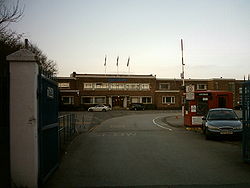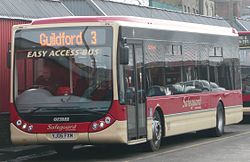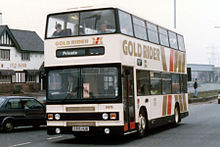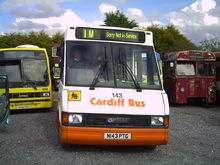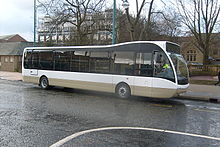- Optare
-
Optare Group Limited Type Public (LSE: OPE) Industry Bus building Founded 1985 Headquarters Manston Lane, Leeds, England, UK Products Buses Website www.optare.com Optare plc is a bus manufacturer and importer based in Leeds and Blackburn, UK. The company operates from three main business units, Bus Manufacturing, Coach Sales and Unitec.[1] The company manufactures a full range of bus types from minibuses to double deckers, from three sites, the primary sites being in Leeds (the former Leyland Bus site) and Blackburn, with a further facility in Rotherham.[1] Luxury mini-coaches are imported from Spain and sold as Optare branded products. As well as bus manufacturing, the group operates a sales division, and the Unitec after-market parts and service network covering the UK.
The Optare name originated in 1985 from the remnants of the Roe operation, in a time of changing and challenging market conditions for UK bus manufacturers, following the breakup of the nationalised manufacturing industry dominated by British Leyland and its subsidiaries, and the breakup of the traditional home markets through the deregulation of bus services and privatisation of the Scottish Bus Group, National Bus Company, PTE operations and many municipal companies.
In the consequent upheaval in markets and demand through the 1980s and 1990s, the Optare business underwent several changes in management. Although it never rose to the order book numbers of the larger post-1980s manufacturers such as Volvo or Dennis, Optare benefited from the opportunity to develop close relationships with particular customers not necessarily tied to larger suppliers, through political or corporate ties. Wilts & Dorset and Reading Buses became notable loyal Optare customers, with several high profile new London operators also choosing Optare as a market differentiator, such as Harris Bus's use of the Optare Excel. Optare also introduced several technological innovations, with an early electric buses trial, introducing the first UK low-floor double decker, the Optare Spectra, and the ground breaking Optare Solo ("so low") low floor midibus, both in 1997.
Optare has developed both body on chassis products and integral designs, and has also exported a number of models. Optare products originally continued on from the inherited Roe models before creating their own designs. Other models were continuations and developments of designs purchased from Metro Cammell Weymann. Optare's own unique products began with a minibus in 1986. It went on to develop several models which were considered stylish compared to contemporary offerings, which initially suffering from a perception of old age due to lack of development. The pattern of stylish designs continued into the 2000s, but with increased competition from other manufacturers and imported designs. In 2008 Optare accepted a complete buyout by an investment firm owned by Roy Stanley, chairman of the Darwen Group, leading to the Darwen takeover a few months later.
In July 2008 the Darwen Group took over the much larger Optare Group Ltd to form the AIM listed company Optare plc, employing 830 people and with a £90million turnover.[2] With the respective histories of the two entities, Optare plc can be considered the successor company to the historical British bus manufacturers Charles H. Roe (through Optare), founded in Leeds in 1923, and East Lancashire Coachbuilders, (through Darwen), founded in 1934 in Blackburn.
The Darwen takeover led to the return of double deck designs to Optare since the last Spectra was built in 2005, joining the predominantly single deck and below production of Optare with the predominantly double deck production of Darwen. It also brought further design expertise in the form of Darwen LPD, the former Leyland/Volvo research division, with an expectation to be launching new hybrid models by the end of 2008.
Contents
History
Formation of Optare
In September 1984, Leyland announced that it was closing the Charles H. Roe vehicle bodywork building business in Leeds. In response, Russell Richardson, a former plant director at Roe, backed by the West Yorkshire Enterprise Board and many redundant former employees, created Optare in February 1985.
The company was created at a very difficult time for the bus and coach industry, with the challenges of privatisation and deregulation meaning very few orders for new vehicles. The first orders came from the still publicly owned West Yorkshire Passenger Transport Executive (WYPTE) and South Yorkshire Passenger Transport Executive (SYPTE), keen to support the locally based company. The publicly owned but arms-length company Yorkshire Rider, as successor to the WYPTE bus fleet, also took some buses from Optare.
When Roe closed down, WYPTE had an unfulfilled order for five Leyland Olympian coach seated double decker buses in place for its Metro coach operation. These five part finished buses went from Roe to Eastern Coach Works as shells for completion, but the following ten were completed as Optare buses but to the Roe design, with the first Optare double decker completed in September 1985, the 17th Optare bus body. Five went to WYPTE, and five to its successor Yorkshire Rider. Five further standard seated Olympians were also delivered to WYPTE, two as convertible open top buses.[3]
The first Optare designed bodies were fourteen Dennis Dominos for SYPTE built starting in February 1986. Optare also bodied fifteen Leyland Cubs for WYPTE. A preserved Cub later visited the Optare plant in 2005.[4]
Starting in August 1986 Optare built fifteen minibuses converted from the Freight Rover Sherpa vans, for WYPTE.[5]
CityPacer and StarRider
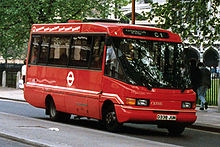 A 1986 London Buses Optare CityPacer taken in the 80s OV6
A 1986 London Buses Optare CityPacer taken in the 80s OV6
In 1986 Optare introduced its first true product, the CityPacer minibus. This was based on a heavier version of the MAN-VW LT55 van chassis, to which Optare made modifications. The engine was a six-cylinder 2.4-litre. The body seated 25, with space for a further 5 standing passengers, a size that met the minibus vogue of the late 1980s. While its competitors looked like the modified vans they were, the CityPacer had attractive styling notable for its large one-piece raked windscreen. London Transport bought 52, and other major operators bought small batches.
Soon after the StarRider was introduced, based on the Mercedes 811D chassis. This was a heavier chassis with a proven reliability record. The StarRider had seating for 33 passengers, although the body styling was less successful. London Transport took 123 StarRiders.
Yorkshire Rider ordered four StarRiders and a CityPacer.[6] An attempt at exporting the StarRider came in the form of the ColumboRider for export to Colombo, Sri Lanka in 1987.
Expansion
In 1988 the first full size Optare product appeared, the Delta. This was a single-deck bus based on the DAF SB220 chassis. The Delta bodywork featured contemporary styling and was aluminium with a bolted frame licensed from Alusuisse. The Delta successfully found a niche in the full-size single deck bus market, which was very limited at that time.
Dennis had effectively created a new market segment, known as a midibus, with the introduction of the Dennis Dart. Optare soon introduced a competitor, the Vecta, albeit slightly bigger and wider than the Dart at that time, seating 40 in a full width 2.50m body. The chassis was based on the MAN 11.190 and featured a ZF gearbox and air suspension. The body was a scaled down version of the Delta.
The CityPacer and StarRider were phased out in the years after Optare purchased the design for the MCW Metrorider in 1989, releasing this as the Optare MetroRider. This was a larger design than the CityPacer, and a heavier and more truly integral product than the StarRider. As such it became the mainstay of the Optare midi/minbus offering until the low floor Solo, and persisted for a few years after the Solo's introduction.
The Spectra double-decker set new standards in design, forcing a rethink of how a double-decker should be styled.
DAF/United Bus
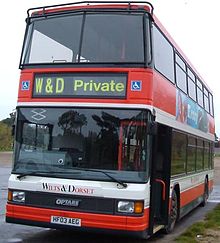 Front view of a Spectra of Wilts & Dorset
Front view of a Spectra of Wilts & Dorset
In 1990, Optare joined a group called the United Bus, which included DAF Bus.
Having already used a DAF SB220 chassis on the Delta, now as part of United Bus, Optare collaborated with DAF to design the Optare Spectra. It was based on the modified design of the MCW Metrobus purchased by Optare, and combined parts from it and the SB220 to form a new double deck chassis, designated DB250, with Optare bodywork called Spectra.[7] Due to the United bus relationship and joint design, the Spectra was built exclusively on DB250 chassis. As well as having a striking front end, the Spectra was also recognisable for having no rear window. Introduced in 1990 it was described as a "partly low-floor double-decker".[8] Despite the association with DAF, in 1991 Optare also launched a conventional height midibus in on a MAN chassis, the Vecta.
After the collapse of United Bus in 1993, Optare was again bought by a management-buyout. The reaction to the collapse of United was the release in the next two years of two Delta derived single deck buses on different non-DAF chassis, the Sigma and Prisma. The Prisma was noticeable in having a generic Mercedes Benz style front end rather than the recognisable Optare family face.
Optare acquired Autobus in 1996, which had just launched their Nouvelle luxury minicoach. Optare slightly redesigned this in 1997 and rebadged it the Nouvelle 2, and served similar markets to the StarRider/MetroRider coach versions. Also in 1997 the relationship with Ferqui started with the importing of the Solera luxury coach.[7]
While part of United, Optare also for a time became the exclusive UK dealer for the distinctive full size Bova Futura coach.
Low floor era
Optare began introduction of low-floor buses in the UK in 1995 with the launch of its first, the Optare Excel full size single decker, in the same year that Dennis launched the Dennis Dart SLF (Super Low Floor) midibus which would go on to dominate the market, although low floor single decker buses had begun to appear as early as 1993. The Excel used Cummins engines and Allison gearboxes to start with and had a fairly poor reputation for reliability. Later examples had Mercedes engines and were better although the reputation of earlier models did nothing to help sales. The Excel marked the start of sustained period of selling integral bus products rather than body on chassis combinations, which continues until the Darwen merger brings in East Lancs models to the range.
With modifications of the DB250 chassis to become the DB250LF, in 1997,[7] the Spectra became the first fully low-floor double decker bus on offer in the UK.
Also in 1997 the Solo was launched and became a success for Optare. With a unique design of a front axle forward of the door, it allowed a low-floor layout in a very short bus, and also came equipped with kneeling suspension for even greater access. It competed against both the shorter Dart SLF models and high floor minibuses. Its styling and innovation led to a Millennium Products award and the Queen's Award for Innovation. A US export version of the Solo also found success at airports.
North American Bus Industries
In 2000, Optare was bought by Hungarian owned North American Bus Industries for £21.5million. This gave Optare products exposure in the North American market. The Excel continued in the US after being discontinued in the UK.
The NABI era saw the introduction of the Alero low-floor minicoach in 2001, filling a gap in the market for a low floor vehicle for use on low usage services such as demand responsive transport, already covered at the higher capacity by the Solo, which was made into longer and narrower variants in 2004 to further capture the market. Also in 2004 was the first new bus model since the Solo, the Tempo, a full size single decker with another striking design, even when considered in the environment of an increasingly stylish competitor products.
On 1 August 2005, North American Bus Industries got into financial difficulties, and speculation about the future of Optare was ended with the announcement that Optare had, once again, been bought by its management, headed by managing director Bob Coombes, for £11.8million. This change did not seemingly affect the further roll out of the new range, leading to the Versa and radically restyled Solo (as the Solo SR), both clearly resembling the same common in house styling as the Tempo, with a distinctive raised part of the body towards the front of the bus.
Darwen takeover
 The Optare logo used before the Darwen reverse takeover.
The Optare logo used before the Darwen reverse takeover.
On 12 March 2008 Optare Group was purchased by Jamesstan Investments, an investment company controlled by the Darwen Group's parent company chairman Ron Stanley, for £10.5m.[9] Jamesstan Investments immediately sold the former Roe Crossgates factory in Leeds to developer Manston Lane Investments for £2.8m, and leased it back for up to 3 yrs at a rent of £280,000 a year.[9] Optare initially remained an independent company[10] but by 17 July 2008, a reverse takeover of Jammesstan by Darwen Group had been completed. It was a reverse takeover as Darwen was the much smaller company, but its AIM listing sees the enlarged Optare gain a stock exchange listing itself. Optare was then renamed Optare Ltd, and the Darwen Group became Optare plc.
In the short period that Darwen Group existed since taking over East Lancs (a mere 144 days), Darwen had lost £2.67m from a £4.4m turnover. It had in this time however paid £2.1m for East Lancs, spent £315,000 to acquire Darwen LPD, and spent £881,000 on restructuring the business. By comparison, Optare had made £812,000 pretax profit on a £57.8m turnover in the last year, down from £1.02m from £54.2m in the previous year.[9]
To complete the takeover, the Darwen Group raised £16m in new shares, which valued Optare at £6.75m, with the balance going to service loan facilities of Optare.[9]
Optare plc
The Optare website was relaunched with a new logo, and with the Olympus and Esteem ex-Darwen models listed as Optare products.
Andrew Brian was installed as the first plc Chief Executive, with Roy Stanley as Chairman, with two other directors. On its creation, Optare plc was 52% owned by its directors. It was unclear what role if any there might be for Russel Richardson, founder of Optare, in the enlarged group.[9]
On the bus manufacturing side of the business, the merger brought together the single deck and below size portfolio of Optare, with the primarily double deck order book of Darwen.
In its short existence, Darwen had essentially not produced a new model since the East Lancs models were rebadged by Darwen, although these were very new designs. However, it had been working with the LPD division on producing a hybrid diesel electric semi-integral version of the Olympus, with a prototype due for completion by July ready for exhibition at Euro Bus Expo in Birmingham in November 2008.[9] This model would use regenerative braking to become the most fuel efficient and lowest emitting model on the UK market.[9]
On the takeover, the new Chief Executive stated that the plc would now capitalise on the opportunity presented by the merger to make hybrid products for a wide variety of customers. Darwen had previously had 90% of its current business with 3 customers, with Optare's equivalent figure at 43%.[9]
In summer 2010, Ashok Leyland (former Indian subsidiary of British Leyland) bought a 26% stake in Optare. However Optare's share price has declined from 9p in the autumn of 2009 to between 2.5p and 3p for much of 2011 despite the promises of new models and production facilities.
Preservation
A number of early Optare vehicles have already entered preservation. Of the very early vehicles, three Dominos are owned by a private owner in Sheffield, of the early WYPTE vehicles, an Olympian, Cub, Delta, Sherpa and Star Rider are preserved by Transport Yorkshire Preservation Group and a number of CityPacers (including Yorkshire Rider 1700 D901MWR) and MetroRiders have been saved including an ex-Cardiff example N143PTG by the Cardiff Transport Preservation Group.
Optare Product Support (formerly Unitec)
The Optare parts and service division Unitec has locations at the Rotherham factory, as well as in Thurrock, Essex and Cumbernauld, Scotland.[1] In 2009 Unitec was renamed to Optare Product Support .[11]
Coach imports
As of 2008, the current minicoach models Toro, Solera and Soroco are imported by Optare from the Spanish manufacturer Ferqui, and marketed as Optare products.[9] They are luxury minicoach bodies built on Mercedes-Benz chassis by Ferqui.
Products
Buses
- Current
- Solo low floor midibus (1997 -) (restyled Solo SR 2007 - ) (Solo+ 2008) (Solo EV 2009-)
- Tempo single decker (2004 -) (restyled Tempo SR 2011 - )
- Versa, midibus between Solo and Tempo (2006 -)
- Discontinued
- CityPacer minibus (1985–1992, replaced by the MetroRider)
- StarRider minibus (1987–1994, replaced by the MetroRider)
- ColumboRider (1987 - ?)
- Delta single decker (1988–1999)
- MetroRider minibus (1989–2000)
- Spectra double decker (1991–1997) low floor (1997–2005)
- Vecta midibus (1991–1997)
- Sigma (1994–1996, single-deck version of the Spectra)
- Prisma (1995–1998) single decker, Mercedes front
- Excel (1995–1999) (Excel 2 1999 - ?, replaced by Tempo)
- Alero low floor minibus, (Alero 2001 - 2006, Alero Plus 2006 - 2008)
- Esteem single decker (formerly East Lancs Esteem) (2008–2009)
- Rapta double decker (2009)[12]
- Olympus double decker (formerly East Lancs Olympus) (2008 -2011)
- Visionaire open-top double decker (formerly East Lancs Visionaire) (2008 -2011)
- OmniDekka double decker (formerly East Lancs Omnidekka), partly replaced by Olympus (2008-2011) now only built to special order (current OmniDekka customers)
Coaches
- Current
An easyBus Soroco
Demonstrator
- YJ59NNZ,Optare Tempo X1200 SABMW6AS09B280143.reg at 2/2010.owned by Optare,Crossgates before sold to First Group.
- YJ57EHD,Optare Solo SR M850 SABFWGAC07L290001.reg at 9/2007.owned by Optare,Crossgates before sold to marshalls.
- YN04LXD Optare Solo M780 SAB19000000001541.reg at 7/2004.owned by Optare,Crossgates before sold to
- P508NWU Optare Excel L1070 VN9071.reg at 2/1997.owned by Optare,Crossgates before sold to Barton.
- Discontinued
Current competitors
References
- ^ a b c "The Optare Group - Group Structure". Optare plc. http://www.optare.com/og_group_structure.htm. Retrieved 2008-07-29.[dead link]
- ^ "Optare plc formed as takeover complete". busandcoach.com. 17 July 2008. http://www.busandcoach.com/newsstory.aspx?id=2031. Retrieved 2008-07-30.
- ^ Transport Yorkshire Preservation Group page for WYPTE 5507
- ^ Transport Yorkshire Preservation Group page for WYPTE 1807
- ^ Transport Yorkshire Preservation Group page for WYPTE 1705
- ^ Transport Yorkshire Preservation Group page for Yorkshire Rider 2004
- ^ a b c www.buszone.co.uk Optare page
- ^ www.busexplorer.com British double decker page
- ^ a b c d e f g h i Buses Magazine, Ian Allen Publishing, August 2008 nissue, "East Lancs name set to disappear as Optare and Darwen agree to merge", News page 6
- ^ Bus and Coach.com Roy Stanley company buys Optare, 12 March 2008
- ^ http://s261370817.websitehome.co.uk/news_detail.php?ID=63&Index=1
- ^ http://www.automotivepr.com/releasedetail.html?&fSKU=2209
External links
- Optare's official website
- A useful listing of all bodies/complete buses built from 1985 to date
- Transport Yorkshire Preservation Group, owners of various preserved Optare vehicles
- Dennis Domino Buses, details of Optare's first design
- Buszone Optare page details of Optare and Reading Transport
Optare Buses Including past East Lancashire Coachbuilders and Darwen Group busesProductsCurrent Discontinued
(Optare)Discontinued
(East Lancs / Darwen)EL2000 · Greenway · MaxCi · European · Opus 2 · Spryte · Flyte · Myllennium · OmniTown · Kinetec · Esteem · 1984-style double-deck · E Type · Cityzen · Pyoneer · Lolyne · Vyking · Lowlander · Myllennium Lolyne · Myllennium Vyking · Myllennium Lowlander · Nordic · Scania OmniDekka · PanaireSee alsoMain companies Related companies Bus transport in the United Kingdom General Articulated buses · Buses in London · Coach services · History · Guided buses and Bus Rapid Transit · Open top buses · Park and ride · Preservation · RoutemasterBy country Private operators Major groupsArriva · ComfortDelGro · FirstGroup · Go-Ahead Group · National Express · RATP · Stagecoach · Transdev · VeoliaBy countryEngland (East England · East Midlands · Greater London · North East · North West · South East · South West · West Midlands · Yorkshire) · Scotland · WalesPublic operators Public authorities Manufacturers Alexander Dennis (Plaxton) · Optare · Wrightbus
Categories:- Optare
- Bus manufacturers
- Manufacturing companies of the United Kingdom
- Companies based in Leeds
- Companies established in 1985
Wikimedia Foundation. 2010.

